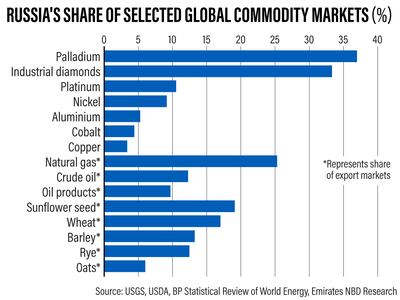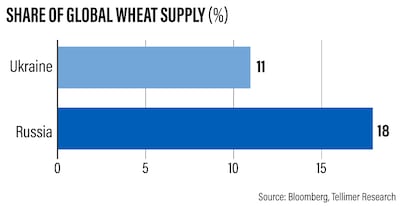Live updates: follow the latest news on Russia-Ukraine
Oil prices rose sharply along with gold on Tuesday on energy supply worries as the Russia-Ukraine crisis escalated after Moscow recognised two breakaway regions of Ukraine and ordered troops into the two territories.
Brent, the global benchmark for two thirds of the world's oil, climbed 3.91 per cent to $99.12 a barrel at 1.39pm UAE time while West Texas Intermediate, the gauge that tracks US crude, rose 4.86 per cent to $95.50 a barrel.
Gold, a safe haven against rising inflation, hit an eight-month high at more than $1,900 an ounce. The price of the yellow metal was already increasing before the latest developments.
“It seems inevitable that Brent crude will test $100 a barrel sooner rather than later,” said Jeffrey Halley, senior market analyst for the Asia-Pacific region at Oanda.
“A full-scale Russian invasion likely sees it spike to $130 [at least], dragging WTI with it. It is hard to see Brent moving back below $90 a barrel anytime soon now, with Opec+ capacity limited in its ability to pump more.”
In his televised address on Monday, Russian President Vladimir Putin recognised the Kremlin-backed separatist regions of Donetsk and Luhansk as republics and said he would send “peacekeeping forces” to protect them. It has yet to be known how many troops Moscow is sending.
The US said it will impose sanctions on Moscow and is “co-ordinating with allies and partners”, a White House representative said on Monday.
Russia accounted for about 12 per cent of global crude oil exports in 2020 and about 10 per cent of total oil product exports, according to Emirates NBD. It supplies 25 per cent of the world's natural gas exports and is also a major producer of industrial metals.
It is the third-largest source of mined nickel ore, which is used in steel alloys and is an important component in the manufacture of batteries.
Russia is also a major source of palladium and a large supplier of aluminium to global markets.
The country export agricultural commodities, accounting for about 17 per cent of global wheat exports between 2020 and 2021, and more than 10 per cent of feed grains such as barley. It is also a dominant supplier of sunflower seed used in vegetable oil production, according to Emirates NBD.
“At a time when many major economies are already enduring decade high inflation, the threat of a major supplier of raw materials being sidelined from markets due to sanctions would add further upward pressure on prices,” said Edward Bell, senior director of market economics at Emirates NBD.
“A further escalation of the crisis into a conflict may delay some of the expected monetary tightening to help assuage nervousness in financial markets but the macroeconomic outcome from a conflict is still likely to end up being inflationary.”

The latest developments “narrow the chances of a Russian pullback, and the window for diplomacy is almost shut”, said Ipek Ozkardeskaya, a senior analyst at Swissquote.
“This is the worst escalation since the Cold War. After the US-China trade war and a global pandemic, the Russian crisis is the next big thing on the world’s agenda. Unfortunately, governments and central banks have limited munition left to fight back a war-induced global recession.”
Before the latest turn of events, Russia had gathered thousands of troops on its side of the border with Ukraine. The US and Nato allies issued repeated warnings that Moscow was preparing to invade Ukraine, allegations that Russia denied several times.
Russian futures shed about 14 per cent on Monday while German Dax futures were trading 4 per cent lower and natural gas futures were up 8 per cent.
Geopolitical tension has added to a sharp rally in Brent prices, which have already touched about $97 a barrel in recent weeks. The rally has been driven by supply constraints.

A fully fledged military conflict between Russia and Ukraine threatens to severely disrupt energy supplies to Europe.
“While markets await the diplomatic response of the US, EU and other nations, as well as any follow up from Russia itself, we would expect oil and energy markets to price in much more supply insecurity,” Mr Bell said.
“Oil markets are acutely tight in the first quarter this year as demand growth has remained robust while supply increases have been haltingly slow.”
Crude prices, which jumped more than 67 per cent last year, have continued their upward momentum, rising more than 15 per cent in 2022 amid tight supply. The inability of oil producers to hit their planned supply output increases in full in recent months has also contributed to higher oil prices.
Underinvestment in oil and gas production over the past few years has hindered the ability of producers to increase output at short notice.
Brent is expected to “overshoot” $125 a barrel this year and $150 a barrel in 2023, given that Opec's spare capacity is below market expectations and impedes its ability to respond to high oil prices, JP Morgan said in December.
The oil price volatility amid a deteriorating geopolitical situation is expected to drive gold prices higher as investors look to safe-haven assets to hedge risks. Spot gold rose 0.18 per cent to $1,909.76 an ounce.
“We would expect more of a move into the havens in the scenario that the crisis in Eastern Europe worsens,” said Khatija Haque, head of research and chief economist at Emirates NBD.
Gold prices fell more than 4 per cent in 2021 after rising 48 per cent over the past two years as the global economic recovery reduced demand for the metal.
The haven commodity traded between $1,676 and $1,959 an ounce last year, after its best annual performance in a decade in 2020, when it hit a record high of $2,072.50.
“Stagflation or a Russian invasion of Ukraine, gold should be a winner in the coming days and weeks,” Mr Halley said.
“Gold appears poised to come into its own and a retest of the previous all-time highs near $2100 an ounce cannot be ruled out.”






